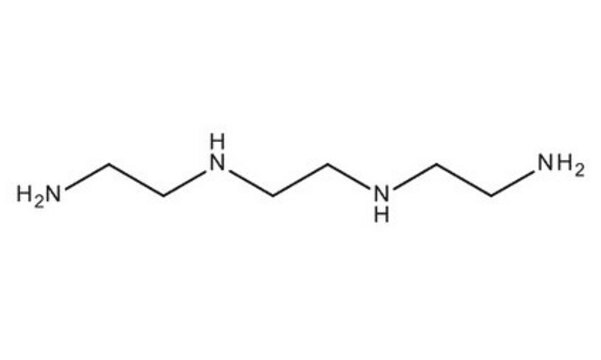D93856
Diethylenetriamine
ReagentPlus®, 99%
Synonyme(s) :
2,2′-Diaminodiethylamine, 2,2′-Iminodiethylamine, Bis(2-aminoethyl)amine
About This Item
Produits recommandés
Densité de vapeur
3.6 (vs air)
Niveau de qualité
Pression de vapeur
0.08 mmHg ( 20 °C)
Gamme de produits
ReagentPlus®
Pureté
99%
Forme
liquid
Température d'inflammation spontanée
676 °F
Limite d'explosivité
6.7 %
Indice de réfraction
n20/D 1.484 (lit.)
Point d'ébullition
199-209 °C (lit.)
Pf
−35 °C (lit.)
Densité
0.955 g/mL at 25 °C (lit.)
Chaîne SMILES
NCCNCCN
InChI
1S/C4H13N3/c5-1-3-7-4-2-6/h7H,1-6H2
Clé InChI
RPNUMPOLZDHAAY-UHFFFAOYSA-N
Vous recherchez des produits similaires ? Visite Guide de comparaison des produits
Description générale
Application
Informations légales
Mention d'avertissement
Danger
Mentions de danger
Classification des risques
Acute Tox. 2 Inhalation - Acute Tox. 4 Dermal - Acute Tox. 4 Oral - Eye Dam. 1 - Skin Corr. 1B - Skin Sens. 1B - STOT SE 3
Organes cibles
Respiratory system
Code de la classe de stockage
6.1A - Combustible acute toxic Cat. 1 and 2 / very toxic hazardous materials
Classe de danger pour l'eau (WGK)
WGK 1
Point d'éclair (°F)
201.2 °F - closed cup
Point d'éclair (°C)
94 °C - closed cup
Équipement de protection individuelle
Faceshields, Gloves, Goggles, type ABEK (EN14387) respirator filter
Faites votre choix parmi les versions les plus récentes :
Déjà en possession de ce produit ?
Retrouvez la documentation relative aux produits que vous avez récemment achetés dans la Bibliothèque de documents.
Les clients ont également consulté
Articles
Kanjiro Miyata (The University of Tokyo, Japan) provides insights on the rational design of polymeric materials for “smart” oligonucleotide delivery.
Notre équipe de scientifiques dispose d'une expérience dans tous les secteurs de la recherche, notamment en sciences de la vie, science des matériaux, synthèse chimique, chromatographie, analyse et dans de nombreux autres domaines..
Contacter notre Service technique











